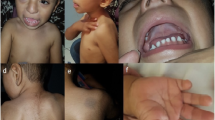Summary
On the basis of phenotypic similarities and differences among patients with a partial trisomy of chromosome 5q, three clinically distinguishable phenotypes are suggested. Each corresponds to a distinct abnormal karyotype in which there is partial duplication of a different segment of the long arm of chromosome 5 (5q+). The hypothesis is derived from 12 published cases of partial trisomy 5q, and from 2 additional new cases of partial trisomy 5q31→qter in a family with a balanced translocation, t(5;11)(q31;q25), in the father. The partial duplications and their corresponding phenotypes are as follows:
-
A.
A proximal duplication, 5q11→5q22, associated with musculoskeletal abnormalities including general hypotrophy, severe muscular asthenia, severe psychomotor retardation, lordosis, scoliosis, spina bifida occulta, protruding sternum, cubitus valgus and genu valgum, dysmorphic face with short nose and thick upper lip, bulging forehead, thin tapering fingers, no simian creases, and dermatoglyphic peculiarities;
-
B.
A distal duplication, 5q31(32/33)→qter, associated with severe retardation of growth and of psychomotor development, microcephaly, epicanthus, strabismus, hypertelorism, antimongoloid slants of the eyes, large upper lip, carpmouth, dental caries, lowset, dysplastic, protruding ears, brachydactyly and clinodactyly, hernias, cardiac malformations, dermatoglyphic abnormalities, and reduced life expectancy;
-
C.
A distal duplication, 5q34→ter, associated with short stature, mild mental retardation, delayed puberty, chronic eczema, hernias, dysmorphic facies including short receding forehead, high nasal bridge, thick alae nasales, prominent nasal tip, dental caries, digital anomalies and normal life expectancy.
Similar content being viewed by others
References
Bartsch-Sandhoff M, Liersch R (1977) Partial duplication 5q syndrome: Phenotypic similarity in two sisters with identical karyotype (Partial duplication 5q33→5qter and partial deficiency 8p23→pter). Ann. Génét. 20:281–284
Curry CJR, Loughman WD, Franke U, Hall BD, Golbus MS, Derstine J, Epstein CH (1979) Partial trisomy for the distal long arm of chromosome 5 (region q34→qter). A new clinically recognizable syndrome. Clin Genet 15:454–461
Ferguson-Smith MA, Newman BF, Ellis PM, Thomson DMG (1973) Assignment by deletion of human red cell acid phosphotase gene locus to the short arm of chromosome 2. Nature New Biol 243:271–273
Jalbert P, Jalbert H, Sele B, Mouriquand C, Malka J, Boucharlat J, Pison H (1975) Partial trisomy for the long arms of chromosome No. 5 due to insertion and further “aneusomie de recombinaison”. J Med Genet 12:418–423
Jones LA, Jordan DK, Taysi K, Strauss AW, Toth JK (1979) Partial duplication of the long arm of chromosome 5: a case due to balanced paternal translocation and review of the literature. Hum Genet 51:37–42
Osztovics M, Kiss P (1975) Familial translocation, t(2;5)(p23; q31). Clin Genet 8:112–116
Schnedl W (1971) Analysis of the human karyotype using a reassociation technique. Chromosoma 34:448–454
Zabel B, Baumann W, Gehler J, Conrad G (1978) Partial trisomy for short and long arm of chromosome no. 5. J Med Genet 15:143–147
Author information
Authors and Affiliations
Rights and permissions
About this article
Cite this article
Rodewald, A., Zankl, M., Gley, E.O. et al. Partial trisomie 5q: Three different phenotypes depending on different duplication segments. Hum Genet 55, 191–198 (1980). https://doi.org/10.1007/BF00291766
Received:
Issue Date:
DOI: https://doi.org/10.1007/BF00291766




